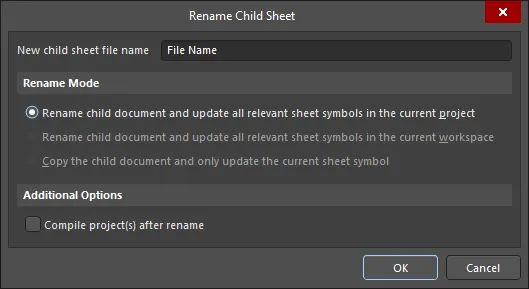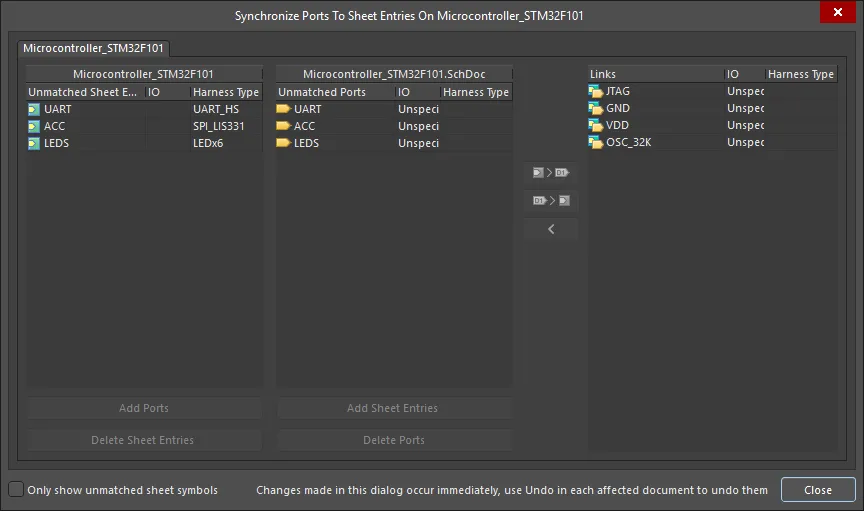Sheet symbols are available for placement in the Schematic Editor in the following ways:
- Choose Home | Circuit Elements | Sheet Symbol from the main menus.

- Right-click in the design space then choose Place » Sheet Symbol from the context menu.
After launching the command, the cursor will change to a cross-hair and enter sheet symbol placement mode. Placement is made by performing the following actions:
- Click or press Enter to anchor the first corner of the sheet symbol.
- Move the cursor to adjust the size of the sheet symbol then click or press Enter to complete placement.
- Continue placing further sheet symbols or right-click or press Esc to exit placement mode.
A new sheet symbol can also be create from a chosen schematic sheet that exists in the project, with
sheet entries for each of the
ports on that sheet. Right-click in the design space then choose
Sheet Actions » Create Sheet Symbol from Sheet from the context menu. In this way, you can quickly build up the required structure for your hierarchical schematic designs in bottom-up fashion. After launching the command, the
Choose Document to Place dialog will open. The dialog lists all candidate schematic documents for the project that can validly be used as the target reference sub-sheet for the new sheet symbol. Choose the required sheet then click
OK; the sheet symbol will be created floating on the cursor. Position the symbol then click or press
Enter to place. The sheet symbol will have the correct file name to link it to the sub-sheet and will have sheet entries to match each of the ports on the sub-sheet.
Additional actions that can be performed during placement while the sheet symbol is still floating on the cursor and before its first corner is anchored are:
- Press the Tab key to access the Sheet Symbol mode of the Inspector panel from where properties for the sheet symbol can be changed on the fly. Click the design space pause button overlay (
 ) to resume placement overlay.
) to resume placement overlay.
- Press and hold the Alt key to constrain the direction of movement to the horizontal or vertical axis depending on the initial direction of movement.
- Press the Spacebar to rotate the sheet symbol counterclockwise or Shift+Spacebar for clockwise rotation. Rotation is in increments of 90°.
- Press the X or Y keys to mirror the sheet symbol along the X-axis or Y-axis.
Graphical Editing
This method of editing allows you to select a placed sheet symbol object directly in the design space and graphically change its size, shape, or location.
When a sheet symbol object is selected, you can click and drag the editing handles to resize the sheet symbol.
 A selected Sheet Symbol
A selected Sheet Symbol
Click anywhere on the sheet symbol away from editing handles and drag to reposition it. While dragging, the sheet symbol can be rotated (Spacebar/Shift+Spacebar) or mirrored (X or Y keys to mirror along the X-axis or Y-axis).
Resizing the sheet symbol will not affect the absolute positions of any defined sheet entries within.
The sheet symbol's Designator and File Name text fields can only be resized by changing the size of the font used (accessed through the appropriate object's Inspector panels). As such, editing handles are not available when either of those objects are selected.
 Selected Designator and Filename for a sheet symbol
Selected Designator and Filename for a sheet symbol
- Click anywhere inside the dashed box and drag to reposition the text object as required. While dragging, the text can be rotated (Spacebar/Shift+Spacebar) or mirrored (X or Y keys to mirror along the X-axis or Y-axis).
- The text for an object can be edited in-place by:
- Single-clicking the designator or filename text to select it.
- Single-clicking again (or pressing Enter) to enter the in-place editing mode. Sufficient time between each click should be given to ensure the software does not interpret the two single-clicks as one double-click (which would open the associated Inspector panel).
- To finish editing in-place text, press Enter or use the mouse to click away from the text object.
To clear the selection of (or de-select) the object, use the Esc key.
Non-Graphical Editing
This method of editing uses the Inspector panel mode to modify the properties of a Sheet Symbol object.
 During placement, the Sheet Symbol mode of the Inspector panel can be accessed by pressing the Tab key. Once the Sheet Symbol is placed, all options appear.
During placement, the Sheet Symbol mode of the Inspector panel can be accessed by pressing the Tab key. Once the Sheet Symbol is placed, all options appear.
After placement, the Sheet Symbol mode of the Inspector panel can be accessed in one of the following ways:
- If the Inspector panel is already open, select the Sheet Symbol object.
- With the Sheet Symbol selected, choose View | Schematic | Inspector from the main ribbons.
Editing Multiple objects
The Inspector panel supports multiple object editing in which the property settings that are identical in all currently selected objects may be modified. When multiples of the same object type are selected manually, an Inspector panel field entry that is not shown as an asterisk (*) may be edited for all selected objects.
Sheet Symbol Actions
Formatting Designator and File Name
The sheet symbol Designator and File Name fields can be formatted independently of the sheet symbol.
The File Name of the sheet symbol (set in the Sheet Symbol mode of the Inspector panel) must be set to the file name of the schematic sheet that the symbol represents.
Right-click Sheet Symbol Commands
Right-click over a placed sheet symbol to access a context-sensitive menu, from which the following commands are available (on the Sheet Symbol Actions sub-menu) that act on that sheet symbol (or all currently selected sheet symbols, where applicable).
 The Sheet Symbol Actions sub-menu
The Sheet Symbol Actions sub-menu
- Open SubSheet "<SheetName.SchDoc>" - use to access the child sheet referenced by the symbol, which will be opened (if not already) and made the active document in the main design window.
- Create Sheet From Sheet Symbol - use to create a new schematic document from the sheet symbol and add ports to that document corresponding to each of the sheet entries on the symbol. In this way, you can automatically create the sub-sheets for a multi-sheet schematic design based on the sheet symbols you have created and placed on the top sheet.
The schematic document that is created is named using the entry in the sheet symbol's File Name field. You can either enter the intended name for the document in this field before launching the command, complete with extension (i.e. DocumentName.SchDoc) or leave the name blank and enter the name when saving the generated document at a later stage.
Care should be taken when creating a sheet from a sheet symbol when a sheet with that file name already exists. A new sheet with the same file name will be created. The duplication can be resolved when saving by either saving the new sheet with a different name or overwriting the existing sheet if required.
- Rename Child Sheet - use to quickly rename the child schematic sheet referenced by the sheet symbol. The Rename Child Sheet dialog will open in which you can specify the new name for the document as required, as well as the scope of the renaming action.

- Synchronize Sheet Entries and Ports - use to synchronize the sheet entries and sub-sheet ports for the sheet symbol. The Synchronize Ports To Sheet Entries dialog will open. Use this dialog to ensure that all sheet entries on the sheet symbol are matched to ports on the referenced child sheet below, both in terms of name and I/O Type.

- Flip Sheet Symbol Along X - use to flip the sheet symbol along the X-axis. The sheet entries associated with the symbol will essentially be swapped to the opposite side of the symbol (in the horizontal plane). Those on the left will be repositioned on the right and vice-versa.
 Example of flipping a sheet symbol along the X-axis
Example of flipping a sheet symbol along the X-axis
If multiple sheet symbols are currently selected, the command will appear as Flip Selected Sheet Symbols Along X. When flipping multiple selected sheet symbols, the symbols will be flipped along an imaginary vertical line that is located mid-way between the bounding extents of the symbols in the selection.
- Flip Sheet Symbol Along Y - use to flip the sheet symbol along the Y-axis. The sheet entries associated with the symbol will essentially be swapped to the opposite side of the symbol (in the vertical plane). Those at the top will be repositioned at the bottom and vice-versa.
 Example of flipping a sheet symbol along the Y-axis
Example of flipping a sheet symbol along the Y-axis
If multiple sheet symbols are currently selected, the command will appear as Flip Selected Sheet Symbols Along Y. When flipping multiple selected sheet symbols, the symbols will be flipped along an imaginary horizontal line that is located mid-way between the bounding extents of the symbols in the selection.
- Toggle All Sheet Entries IO Type in Sheet Symbol - use to toggle the I/O Type for all sheet entries in the sheet symbol simultaneously where applicable.
 Example result of toggling sheet entry I/O
Example result of toggling sheet entry I/O
The actual change depends on the current PortIO Type as follows:
- Unspecified remains Unspecified.
- Output changes to Input.
- Input changes to Output.
- Bidirectional remains Bidirectional.
Tips
- If a group of sheet entries is pasted into a selected sheet symbol and those entries fall outside the current bounds of the symbol, it will automatically be resized to accommodate them.
- By using sheet symbol instantiation, multiple channels on the same sub-sheet can be referenced from a single sheet symbol. The syntax used involves the use of the Repeat keyword in the sheet symbol's Designator field and takes the form:
Repeat(SheetSymbolDesignator, FirstInstance, LastInstance), where SheetSymbolDesignator is the base name for the sheet symbol and FirstInstance and LastInstance together define the number of channels to be instantiated. The FirstInstance parameter must start at a value of one (1).
- Multiple sub-sheets may be referenced by a single sheet symbol. Separate each filename by a semi-colon in the File Name field. With the effective use of off-sheet connectors placed on the sub-sheets, you can spread a section of your design over multiple sheets treating them as though they are one giant (flat) sheet. Note, however, that use of off-sheet connectors is only possible for sheets referenced by the same sheet symbol.